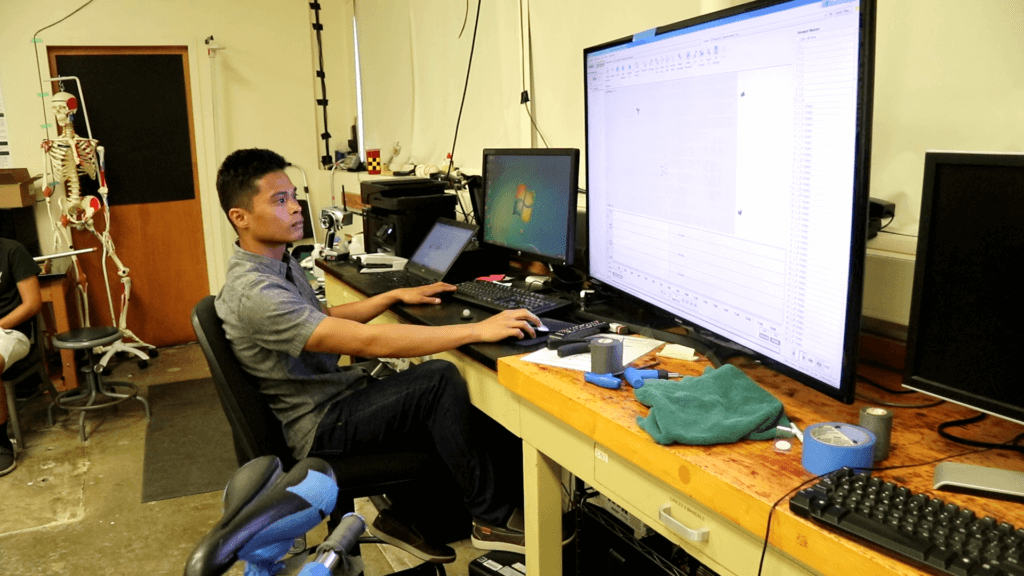Reymil Fernandez lit up the first time he encountered the Human Motion Biomechanics Laboratory.
“When I first walked into that lab, I looked like a happy child,” he recalled. “A happy child – that was my first reaction to it.”
His work in the lab helped inspire him to focus his career objectives and eventually pursue a masters degree at Cal Poly. And now Fernandez, from Bakersfield, is graduating with Outstanding Graduate Student honors.
In high school, Fernandez enjoyed math, but he wanted to pursue a field that was more practical than theoretical. Engineering, he learned, entailed math but also a lot of hands-on work as well.
“You’re applying mathematics and physics concepts in to solving engineering problems,” he said. “I specifically chose mechanical engineering because of its broad aspect.”
A first-generation college student who has funded 100 percent of his undergraduate and graduate studies, Fernandez transferred to Cal Poly from Bakersfield College as a mechanical engineering student. In 2017, he approached professors Scott Hazelwood and Steve Klisch about working in the Human Motion Biomechanics Lab. At the time, the lab was in the middle of a 3-year study, sponsored by the Department of Defense, looking at how exercise impacts amputees with prosthetics.
“One of the biggest challenges is how to integrate man-made materials that can be quite stiff with living, less-stiff biological tissues that have various responses to the objects they are interacting with,” said Scott Hazelwood, a biomedical engineering professor. ”The main contribution of my students and myself on these projects was to use the information gathered from the motion analysis experiments to generate whole knee computational models to examine the build-up of pressure on the cartilage on the knee – and, therefore, the risk of arthritis – throughout the motions of these exercises.”
The studies entailed using real people, wearing retroreflective markers as 12 motion capture cameras recorded their exercise.

Fernandez was one of the students who helped on that study.
“The idea is to investigate hip and knee forces on amputee participants to see which exercise is best for them to minimize the risk of arthritis at the knee,” he said. “We looked at the knee compressive forces and compared that with controls (non amputees).”
Fernandez, who is writing a journal paper on that research, also helped research the arthritis risk for obese individuals who exercise. As an undergraduate, he also took part in the Summer Undergraduate Research Program. His project used the lab’s equipment in a novel way – verifying sensor data recorded from a scaled-down autonomous semi truck.
While an undergraduate, he also attended the Society of Biomechanics Conference in 2019, which motivated him to pursue a graduate degree. He wanted to continue his studies at Cal Poly because of the lab.
Fernandez, whose mother is a caregiver, hopes to have a career in the biomedical device industry because he wants to impact positive change in the lives of others.
“The human motion biomechanics mission statement is to do work that benefits society,” he said. “And I’ve always had this motivation to help people.”
Steve Klisch, a mechanical engineering professor, said Fernandez’s motivation was obvious from the day he stepped into the lab.
“I distinctly remember him saying that a major reason he was interested in the position was because he was very attracted to our lab’s goal of improving lives through injury and disease prevention biomechanics,” said Klisch, who nominated Fernandez for the recognition. “In other words, to reduce pain and suffering in human lives.”
Hazelwood, who leads the lab with Klisch, Brian Self and Christie O’Hara, noticed the enthusiasm that day as well.
“It was clear during that interview that he strongly felt this was what he was meant to do and he certainly was able to convey that to us during the interview,” Hazelwood said.
Fernandez was trained by other former lab members, Hazelwood said, and quickly became involved in studies involving transtibial amputees and obese individuals, among others. Eventually, he became the lab manager, overseeing the everyday operation of the lab and mentoring other students.
“I find Rey to be a very hard working individual, intelligent, well-mannered, easy to talk to, very willing to learn, and ambitious,” Hazelwood said. “He has helped advance the capabilities of the lab by extending the research we do in the lab.”
In his nomination, Klisch noted that Fernandez is a leader in the lab, with five conference papers.
“In my 20 years of research and activities at Cal Poly, I have never worked with another student who has more scholarly and professional potential than Rey,” Klisch wrote.


